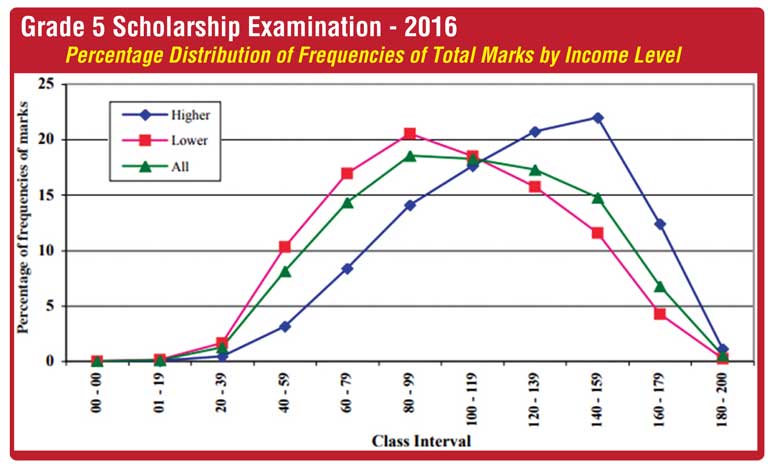Thursday Mar 13, 2025
Thursday Mar 13, 2025
Tuesday, 24 October 2017 00:00 - - {{hitsCtrl.values.hits}}

The Grade 5 scholarship examination results have been released recently. Although this is known as the “Mothers’ exam,” the mentality of the children can be well articulated when children come from the examination halls after the exams. Today we can really experience that so-called “competition” in the education system is negatively affecting the country and the nation with many bad repercussions.
The basic objectives of conducting the Grade 5 Scholarship Exam are:
1. Admission of bright students to popular schools.
2. Provision of bursaries to bright but economically disadvantaged students.
However in pursuit of the above objectives we must look back whether we have forgotten the main core value of education in holistic perspective. As we observed cut-off marks of the examination this year were within the range of 160. In Colombo District that was recorded at 164. 
Imagine that if a student obtains 162 marks (that is 81 marks per subject for an exam which consists of two subjects) that student is labelled as “failed” at the school. Failure of a student who acquired 81 marks for a subject seriously questions both the Grade 5 Scholarship Exam system and the methodology of achieving goals in education.
According to experts in child psychology, nine to 11 year old children are in a transitive period and are emotional in nature, needing a lot of attention from parents, society and friends. In education there is a need to get the opinion of all stakeholders (like experts in higher education, child psychology, administration, environment, etc.). We need to sit and study this carefully. Authorities should be more conscious of loading an unnecessary burden on the child as it would badly affect the development of the child.
Furthermore, according to the latest reports of the Department of Examination, it is clear that there is a difference between the marks of the children with high income level and low income level. That is, a high pass rate can be seen among children with high income level and a low pass rate can be seen with students in the low income range. This actually sends a message to reconsider the methodology of conducting the Grade 5 Scholarship Examination and its core objectives. The chart has been extracted from the Department of Examination ‘reviewing of performance’ report of Grade 5 Scholarship 2016 and the same observation can be seen in the past few years.
Although the village school should be the best school, it must be acknowledged that thousands of children who were in rural areas with less facilities are now in high positions in society with the help of the Grade 5 Scholarship Exam. With surveillance through society, it is clear that we must think as a country and make a positive difference in the education system. Here, we can suggest a different performance criterion in giving admission for skilled children to popular schools for the Grade 5 exam.
Giving children proper respect for their exam performances is our utmost duty. Moreover we should adjust our education system with teaching and learning methods of the countries (good practices) that have gained success in the field of education like Finland and Japan.
There is a need to learn the history of Universities like Nalanda University to observe Adyapana (dealing with brain) and Dhyapana (dealing with heart) which is a must in order to assimilate to establishment. Anyway there is a need to understand the needs of the country with our own competencies. We should sit and reflect! That is the lesson we can learn from this year’s Grade Five Scholarship Examination.
Discover Kapruka, the leading online shopping platform in Sri Lanka, where you can conveniently send Gifts and Flowers to your loved ones for any event including Valentine ’s Day. Explore a wide range of popular Shopping Categories on Kapruka, including Toys, Groceries, Electronics, Birthday Cakes, Fruits, Chocolates, Flower Bouquets, Clothing, Watches, Lingerie, Gift Sets and Jewellery. Also if you’re interested in selling with Kapruka, Partner Central by Kapruka is the best solution to start with. Moreover, through Kapruka Global Shop, you can also enjoy the convenience of purchasing products from renowned platforms like Amazon and eBay and have them delivered to Sri Lanka.
Discover Kapruka, the leading online shopping platform in Sri Lanka, where you can conveniently send Gifts and Flowers to your loved ones for any event including Valentine ’s Day. Explore a wide range of popular Shopping Categories on Kapruka, including Toys, Groceries, Electronics, Birthday Cakes, Fruits, Chocolates, Flower Bouquets, Clothing, Watches, Lingerie, Gift Sets and Jewellery. Also if you’re interested in selling with Kapruka, Partner Central by Kapruka is the best solution to start with. Moreover, through Kapruka Global Shop, you can also enjoy the convenience of purchasing products from renowned platforms like Amazon and eBay and have them delivered to Sri Lanka.